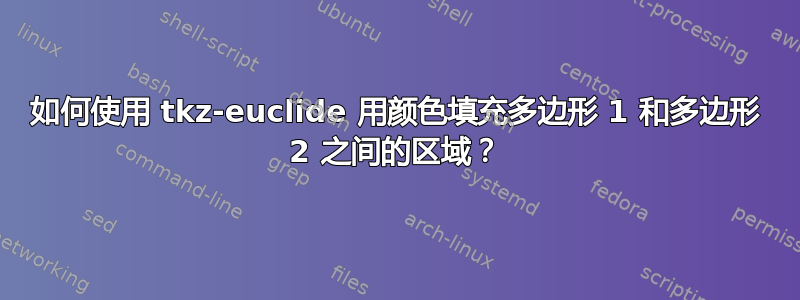
\documentclass{standalone}
\usepackage{tkz-euclide}
\begin{document}
\begin{tikzpicture}[scale=1]
%polygon1
\tkzDefPoint(0,0){P1}
\tkzDefShiftPoint[P1](4,0){P2}
\tkzDefShiftPoint[P2](0,4){P3}
\tkzDefParallelogram(P1,P2,P3)
\tkzGetPoint{P4}
\tkzDrawPolygon(P1,P2,P3,P4)
%polygon2
\tkzDefPoint(1,1){Q1}
\tkzDefShiftPoint[Q1](2,0){Q2}
\tkzDefShiftPoint[Q2](0,2){Q3}
\tkzDefParallelogram(Q1,Q2,Q3)
\tkzGetPoint{Q4}
\tkzDrawPolygon(Q4,Q3,Q2,Q1)
%how to fill the area between polygon 1
%and polygon 2 with color using tkz-euclide?
\end{tikzpicture}
\end{document}
答案1
实际上,解决方案是使用的,但几天后版本 4TikZ就会推出解决方案。tkz-euclide
版本 2 仅tkz-euclide
\documentclass{standalone}
\usepackage{tkz-euclide}
\tikzset{reverseclip/.style={insert path={
(current bounding box.south west) --(current bounding box.north west)
--(current bounding box.north east) -- (current bounding box.south east)
-- cycle} }}
\makeatletter
\newif\iftkzClipOutPoly%
\pgfkeys{tkzclippolygon/.cd,
out code/.is if = tkzClipOutPoly,
out/.code = \tkzClipOutPolyfalse}
\def\tkzClipPolygon{\pgfutil@ifnextchar[{\tkz@ClipPolygon}{\tkz@ClipPolygon[]}}
\def\tkz@ClipPolygon[#1](#2,#3){%
\tkzClipOutPolytrue
\pgfqkeys{/tkzclippolygon}{#1}%
\iftkzClipOutPoly
\clip (#2)
\foreach \pt in {#2,#3}{--(\pt)}--cycle[reverseclip];
\else
\clip(#2)
\foreach \pt in {#2,#3}{--(\pt)}--cycle[reverseclip] ;
\fi
}%
\makeatother
\begin{document}
\begin{tikzpicture}[scale=1]
%polygon1
\tkzDefPoint(0,0){P1}
\tkzDefShiftPoint[P1](4,0){P2}
\tkzDefShiftPoint[P2](0,4){P3}
\tkzDefParallelogram(P1,P2,P3)
\tkzGetPoint{P4}
%polygon2
\tkzDefPoint(1,1){Q1}
\tkzDefShiftPoint[Q1](2,0){Q2}
\tkzDefShiftPoint[Q2](0,2){Q3}
\tkzDefParallelogram(Q1,Q2,Q3)
\tkzGetPoint{Q4}
\tkzDrawPolygon(P1,P2,P3,P4)
\begin{scope}
\tkzClipPolygon[out](Q1,Q2,Q3,Q4)
\tkzFillPolygon[blue!10](P1,P2,P3,P4)
\end{scope}
\tkzDrawPolygon(Q1,Q2,Q3,Q4)
\end{tikzpicture}
\end{document}
带圆圈
\documentclass[tikz,border=2cm]{standalone}
\usepackage{tkz-euclide}
\begin{document}
\begin{tikzpicture}
\tkzDefPoint(0,0){O}
\tkzDrawCircle[R](O,4)
\tkzDrawCircle[R](O,2)
\begin{scope}
\tkzClipCircle[out,R](O,2)
\tkzFillCircle[R,teal](O,4)
\end{scope}
\end{tikzpicture}
\end{document}
版本 1
\documentclass{standalone}
\usepackage{tkz-euclide}
\tikzset{reverseclip/.style={insert path={
(current bounding box.south west) --(current bounding box.north west)
--(current bounding box.north east) -- (current bounding box.south east)
-- cycle} }}
\begin{document}
\begin{tikzpicture}[scale=1]
%polygon1
\tkzDefPoint(0,0){P1}
\tkzDefShiftPoint[P1](4,0){P2}
\tkzDefShiftPoint[P2](0,4){P3}
\tkzDefParallelogram(P1,P2,P3)
\tkzGetPoint{P4}
%polygon2
\tkzDefPoint(1,1){Q1}
\tkzDefShiftPoint[Q1](2,0){Q2}
\tkzDefShiftPoint[Q2](0,2){Q3}
\tkzDefParallelogram(Q1,Q2,Q3)
\tkzGetPoint{Q4}
\tkzDrawPolygon(P1,P2,P3,P4)
\begin{scope}
\clip (Q1)-- (Q2) -- (Q3) -- (Q4) -- cycle [reverseclip];
\tkzFillPolygon[blue!10](P1,P2,P3,P4)
\end{scope}
\tkzDrawPolygon(Q1,Q2,Q3,Q4)
\end{tikzpicture}
\end{document}
答案2
那么,如果没有 tkz-euclide,代码更少,结果更多,会怎么样呢?
\documentclass[border=5mm]{standalone}
\usepackage{tikz}
\begin{document}
\begin{tikzpicture}
%squares
\filldraw[cyan!50] (0,0) rectangle (5,5);
\filldraw[white] (1,1) rectangle (4,4);
\filldraw[cyan!50] (0,-6) rectangle (5,-1);
\filldraw[white] (1,-4) rectangle (3,-2);
%circles
\filldraw[cyan!50] (8,2.5) circle (2.5);
\filldraw[white] (8,2.5) circle (1.5);
\filldraw[cyan!50] (8,-3.5) circle (2.5);
\filldraw[white] (7,-3) circle (1);
\end{tikzpicture}
\end{document}
如果你还想要边框:
你稍微修改一下代码:
%squares
\filldraw[fill=cyan!50,line width=1pt] (0,0) rectangle (5,5);
\filldraw[fill=white,line width=1pt] (1,1) rectangle (4,4);






